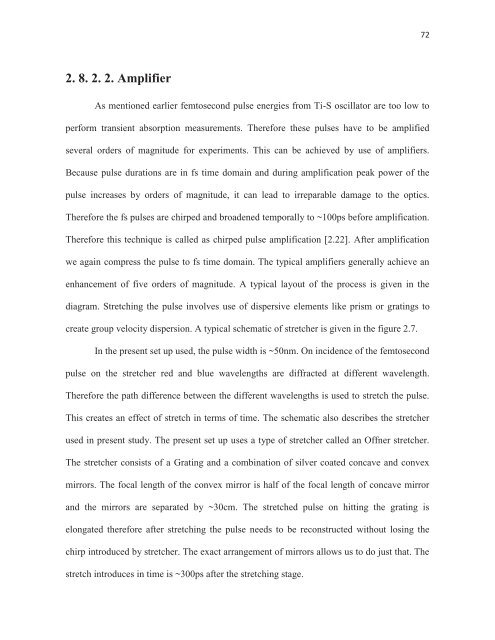CHEM01200604009 Sreejith Kaniyankandy - Homi Bhabha ...
CHEM01200604009 Sreejith Kaniyankandy - Homi Bhabha ...
CHEM01200604009 Sreejith Kaniyankandy - Homi Bhabha ...
Create successful ePaper yourself
Turn your PDF publications into a flip-book with our unique Google optimized e-Paper software.
72<br />
2. 8. 2. 2. Amplifier<br />
As mentioned earlier femtosecond pulse energies from Ti-S oscillator are too low to<br />
perform transient absorption measurements. Therefore these pulses have to be amplified<br />
several orders of magnitude for experiments. This can be achieved by use of amplifiers.<br />
Because pulse durations are in fs time domain and during amplification peak power of the<br />
pulse increases by orders of magnitude, it can lead to irreparable damage to the optics.<br />
Therefore the fs pulses are chirped and broadened temporally to ~100ps before amplification.<br />
Therefore this technique is called as chirped pulse amplification [2.22]. After amplification<br />
we again compress the pulse to fs time domain. The typical amplifiers generally achieve an<br />
enhancement of five orders of magnitude. A typical layout of the process is given in the<br />
diagram. Stretching the pulse involves use of dispersive elements like prism or gratings to<br />
create group velocity dispersion. A typical schematic of stretcher is given in the figure 2.7.<br />
In the present set up used, the pulse width is ~50nm. On incidence of the femtosecond<br />
pulse on the stretcher red and blue wavelengths are diffracted at different wavelength.<br />
Therefore the path difference between the different wavelengths is used to stretch the pulse.<br />
This creates an effect of stretch in terms of time. The schematic also describes the stretcher<br />
used in present study. The present set up uses a type of stretcher called an Offner stretcher.<br />
The stretcher consists of a Grating and a combination of silver coated concave and convex<br />
mirrors. The focal length of the convex mirror is half of the focal length of concave mirror<br />
and the mirrors are separated by ~30cm. The stretched pulse on hitting the grating is<br />
elongated therefore after stretching the pulse needs to be reconstructed without losing the<br />
chirp introduced by stretcher. The exact arrangement of mirrors allows us to do just that. The<br />
stretch introduces in time is ~300ps after the stretching stage.
















